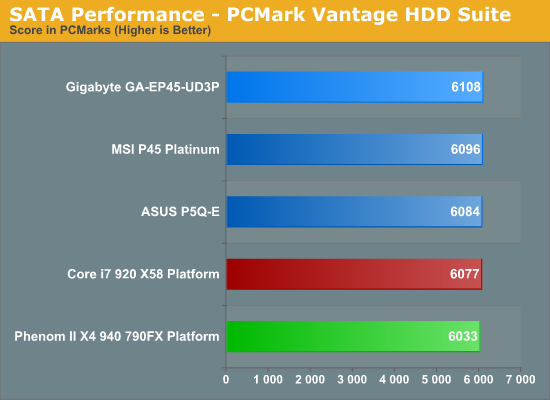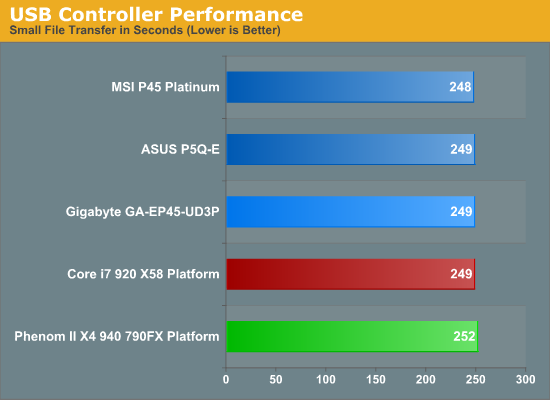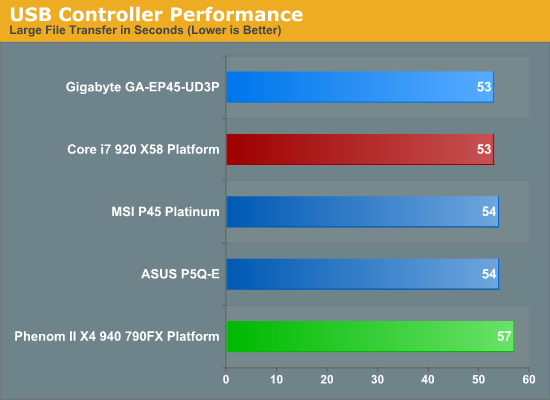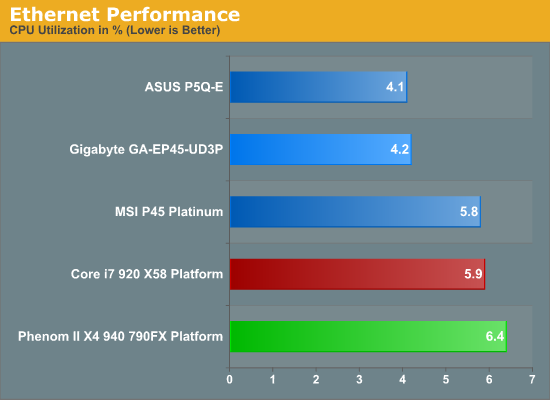Gigabyte GA-EP45-UD3P - P45 at its Finest
by Gary Key on February 3, 2009 12:15 AM EST- Posted in
- Motherboards
SATA Performance
PCMark Vantage is the latest benchmark available from Futuremark, and it is only for use with Windows Vista. Similar to the venerable PCMark05 in its makeup, Vantage modernizes the criteria and test methodology to reflect what users may encounter when running the new Windows OS and current applications. The total HDD benchmark is roughly 87% reads and 13% writes in nature. We run each test five times per drive, producing a median score that we use for comparison in our charts. We enable AHCI settings for each board and download the latest driver set from the manufacturer.

All of the P45 boards utilize the ICH10R for primary storage duties, so there is little difference between the results. ASUS normally finishes first in our storage tests but GIGABYTE was able to pull slightly ahead with the GA-EP45-UD3P.
USB / FireWire Performance
Our USB transfer speed tests are conducted with an OCZ Rally 2 Turbo 4GB Flash Drive and USB 2.0/FireWire based Maxtor OneTouch II external hard drive. In the small file test, we transfer a 602MB folder containing 444 files of various sizes from our hard drive to the USB Flash drive. In the large file test, we transfer a 1.90GB file folder containing 17 different files from our hard drive to the external drive utilizing the USB 2.0 and IEEE 1394a interface.



USB performance is a wash since all of the P45 boards use the same ICH10R chipset that provides the USB capabilities. While our synthetic HD Tune tests indicate parity between the boards, the actual transfer of files in the small file test indicates a slight advantage to MSI's implementation. Our large file USB test basically results in a tie as we are comparing the same chipset and the external hard drive becomes the limiting factor. The VIA and LSI FireWire solutions on the MSI and ASUS boards hold a small advantage over the Texas Instruments chipset on the GIGABYTE board.
Networking
The Windows 2000 Driver Development Kit (DDK) includes a useful LAN testing utility called NTttcp. We used the NTttcp tool to test Ethernet throughput and the CPU utilization of the various Ethernet Controllers used on the Intel motherboards. We set up one machine as the server; in this test, an Intel system with an Intel CSA Gigabit LAN connection. Intel CSA has a reputation for providing fast throughput and is a logical choice for our Gigabit LAN server.
On the server side, we used the following Command Line as suggested by the VIA whitepaper on LAN testing:
Ntttcpr -m 4,0,‹server IP› -a 4 -l 256000 -n 30000
On the client side (the motherboard under test), we used the following Command Line:
Ntttcps -m 4,0,‹client IP› -a 4 -l 256000 -n 30000
At the conclusion of the test, we captured the throughput and CPU utilization figures from the client screen.


Our network throughput test indicates how well a particular controller design from Realtek, Marvell, or Intel performs instead of being indicative of true chipset performance. This also holds true for the CPU utilization results, though this test can also be influenced to certain degree by the BIOS code and chipset interconnect design.
The CPU utilization and throughput numbers favor the Marvell controller on the ASUS board, followed closely by the Realtek chipsets on the MSI and GIGABYTE boards. In practice, few if any users will notice a difference, even if they have the requisite gigabit hub, as storage performance frequently bottlenecks the actual transfer rates.










73 Comments
View All Comments
Norm VH - Monday, August 17, 2009 - link
I am rebuilding in an old computer case using the Gigabyte EP45-Ud3P motherboard. Have new e7500 cpu. New evga 9500 Gt video card. new Corsair ddr2 ram and a new antec earthwatts psu. Before I add all the rest of the items I am checking fan features. Board lights come on. Case fans work. video card fan works. But the Zalman 9700 fan just jumps a little and stops. The Intel fan that came with the CPU does the same thing. Tried cpu fans in both cpu_fan 4 pin and the sys_fan2. Is this normal? Is the fan waiting for the CPU to heat up? I returned a motherboard to Fry's for the same behavior. They said fans should start. I tested the fans on an old asus motherboard and they are working.Isme - Thursday, December 3, 2009 - link
Yes On my EP45-UD3L there is a warm up time before the CPU fan needs to turn on. Its not long for most heat sinks. Maybe 5-10 seconds. You see the CPU fan twitch then sit idle for a time related to how big the heat sink itself is.For modern CPUs you should not need to worry about CPU overheat while messing around with the CPU fan unless you already have cranked voltages for extreme overclocking. The CPU should shut itself off within 10C and 30 seconds of reaching maximum normal operating temperature. I would not do any overclocking until you get fans and other basics working.
lancerocke - Friday, July 24, 2009 - link
so there is no fix for this crackling audio?i kinda want to return this board now.
Voldenuit - Tuesday, August 18, 2009 - link
Sadly, I just got an EP45-UD3P Rev1.1, and the onboard audio still crackles. :(Running Win7 Ultimate RC.
syseng - Friday, June 12, 2009 - link
My second Gagabyte board of this model has died. The first one was DOA and this second one died more gradually. The problem is that it woudl sometimes refuse to turn on or off with the power button. Pressing the button mutliple times or holding it in sometimes worked. Finally, it would not power up at all. I have grounded the pin 16 of the system power connector to start and run the system until I can get a replacement. I have read many comments from varous forums of people having power control problems with this board. Mine was never over-clocked and no power management control was on.Gigabyte will not ship a replacement until they receive the dead board and test it. Estimated round trip time to get the board back is about 3 weeks. Probably the last Gigabyte for me. When I built this system in March, I ordered a Gigabyte 4850 graphics card (all from Newegg) and it was DOA too.
I am just wondering if I am incredibilty unlucky with Gigabyte or if they really have a quality problem. They certainly have a customer service problem if they think it is acceptable to have a system down for 3 weeks.
keithh - Wednesday, May 13, 2009 - link
I decided to give Gigabyte a shot for my latest system build and purchased the EP45-UD3L for the kid's linux desktop. I was using a PATA DVD drive to install to an older IDE HD. After the installation started, the system abrupty died. After resetting, the bios was unable to see the drives. Cutting a long story short, I concluded that the motherboard was bad and exchanged it.The second board had exactly the same problem.
After switching to an ASUS motherboard, I had no problems.
I eliminated the following possibilities during my investigation:
- master/slave settings
- IDE cable
- DVD drive
- IDE drive (tried a SATA drive from another machine)
- RAM test
- BIOS revision (F2 -> F4 didn't make a difference)
- installing Windows XP from a disk that is known to be good
- installing two different Linux distributions including Fedora 10.
It uses the JMicron 368 PATA chipset which has a dodgy reputation so conceivably using a SATA DVD drive and a SATA HD would have worked.
The power supply was a brand new Corsair.
That doesn't leave a lot of room for interpretation - I was 0/2 on the Gigabyte MB. I wasn't impressed.
syskin - Saturday, February 21, 2009 - link
Hi, I have one question which is very important to me.If I:
- overclock FSB and
- set a higher Vcore voltage and
- activate EIST/speedstep,
...will this motherboard still lower Vcore at idle (as per speedstep) or will it keep it at bios setting all the time?
Thank you in advance.
foofoo - Tuesday, February 17, 2009 - link
I have 2 x 2GB RAM installed and winXP pro 32 bit only sees 2.5GB. The BIOS (f7) sees all 4GB. Changed RAM and slots with the same results. I put in a trouble ticket to Gigabyte support and got the following response (or non-response)"You will need to use 64 bit OS in order to see the full 4gb capacity or higher
Windows will automatically reserve an certain amount of memory being used and there are no way to adjust it"
All other gigabyte boards that I have used (965 and P35 chipsets) show 3.5GB with 4 installed under XPpro. This is actually a game stopper for me since losing that much RAM affects the usefulness of my PC.
Fair warning for all wanting to use a 32 bit OS with this board.
Isme - Thursday, December 3, 2009 - link
Make sure you are looking at BIOS RAM reports especially the POST. Or I'd use the Task Manager Physical Memory report or the built-in Windows Accessories-System Tool-System Information-System Summary tab-Total Physical Memory line before I panic about hardware issues. Note that on one of my computers I have only 1.19GB available out of 2029MB. Application reports of RAM are pretty much useless except for that application at that point in time with whatever else happens to be running. Know how 3rd party utility tools define available RAM.Well the amount of RAM visible varies. Depending on OS and reporting tool 1GB may be reserved for the OS. That is the standard 32-bit Windows OS only has 3GB RAM for user purposes. With older very basic peripheral devices and XP that often included memory mapped IO space. But with newer larger OSes and huge numbers of motherboard ports and video cards sporting 1GB+, dedicated SATA port buffer frames, dedicated buffers for fancy network ports...
Remaining RAM space, especially user space, may be more dependent on how much of the 4GB space is mapped for peripherals in your particular setup. I would not be surprised if some video cards are mapping 512MB or more to main memory as a window now that 1GB+ video cards are common. I suppose a less considerate video BIOS might even automatically reserve space for an X-fire setup even if you are not using one.
pudlglum - Sunday, February 15, 2009 - link
Thanks for all the excellent knowledge on the AnandTech Forum. I believe this is my first post on any forum, and I've been into PCs since purchasing my brand new Compaq Portable 286, with 256K ram and a single 1.2 Mb floppy.I've had a GA-EP45-UD3R running for about a week. All components are conventional, all good quality, nothing is "bleeding edge", and I'm not overclocking. I have an ATI Radeon HD 4350 PCI-e graphics card, connected to a Hitachi CM751 CRT monitor. Two WD SATA hard drives are connected to the Intel (yellow) connections, configured in the BIOS to IDE mode. My reliable Plextor PX-760A CD/DVD burner is connected as "master" to the single IDE connection.
Everything was smooth except for two things: occasionally the screen resolution was corrupted when resuming from standby, and I was getting disk write failures from both an old (4X) CD burner and my recent Plextor PX-760A CD/DVD burner.
I downloaded whatever recent drivers I could find; the video problem hasn't recurred, but ImgBurn or CDBurnerXP both froze while attempting to write an iso image (Windows 7 Beta) to a DVD. ImgBurn locked both itself and Explorer, and required a forced reboot. CDBurnerXP Pro provided the following error message:
Writing Error: (3) Error occurred writing data to disc.
The SCSI/ATAPI bus was reset and caused a write failure (1026).
Error Sense Data: SENSE KEY: 6 ASC: 29 ASCQ: 0
Apparently both IDE and the purple SATA2 connectors are controlled by the "Gigabyte SATA2" chip, enabled in my BIOS in IDE mode. It is listed in the Device Manager "SCSI and RAID controllers" section as "GIGABYTE GBB36X Controller", with driver provider "JMicron Technology Corp". I was distracted by several suggestions that the JMicron driver was buggy, but that was just a wild-goose-chase.
I then pursued some marginal comments about DPC latency. The comments were typically in the context of audio crackling issues, which I had not (yet) noticed. However, several posts also referred to the Gigabyte Energy Saver service. I had not knowingly installed that package from the Gigabyte motherboard CD, but I found the GSvr.exe service running, with description "GEST service for power management". It also appeared in my Start menu, under GIGABYTE > EnergySaver.
I downloaded DPC Latency Checker V1.1.0 and discovered that my latency was averaging around 500µs, with all "foreground" applications closed, and with Windows Desktop Search and Avast Antivirus disabled. Running ImgBurn in this condition resulted in a another DVD coaster.
After hard-rebooting, I disabled the GSvr.exe service, and confirmed that the DPC latency dropped to around 5µs. This time, ImgBurn successfully wrote the iso file to the DVD (yay!).
I have now uninstalled GSvr.exe (GIGABYTE > EnergySaver > Uninstall), and re-enabled Windows Desktop Search and Avast. In the last half hour or so, my DPC Latency has continued to average about 5µs, with an absolute maximum of 177µs. I suspect removing the Gigabyte EnergySaver service will solve both my disk burning and standby/wakeup problems.